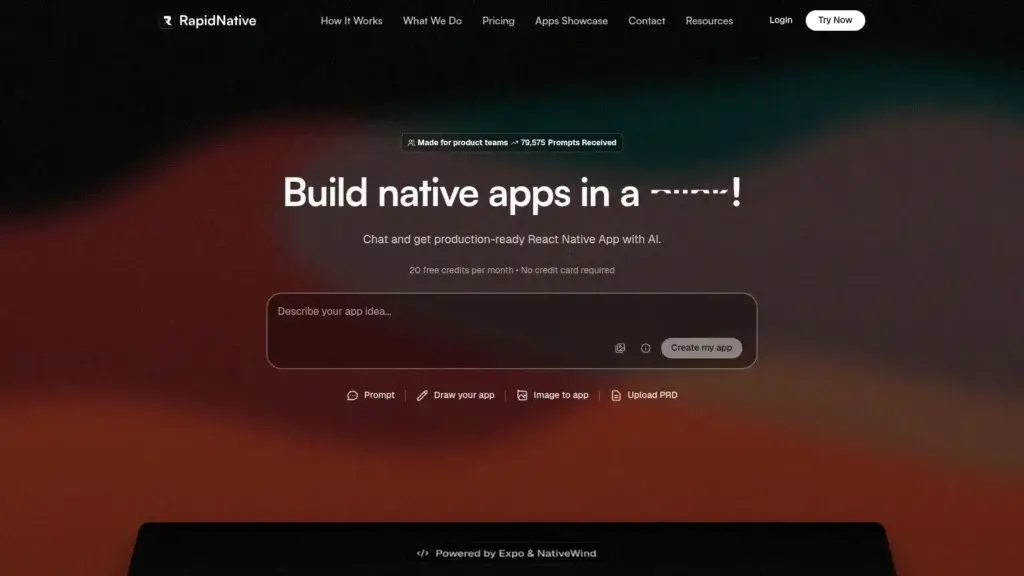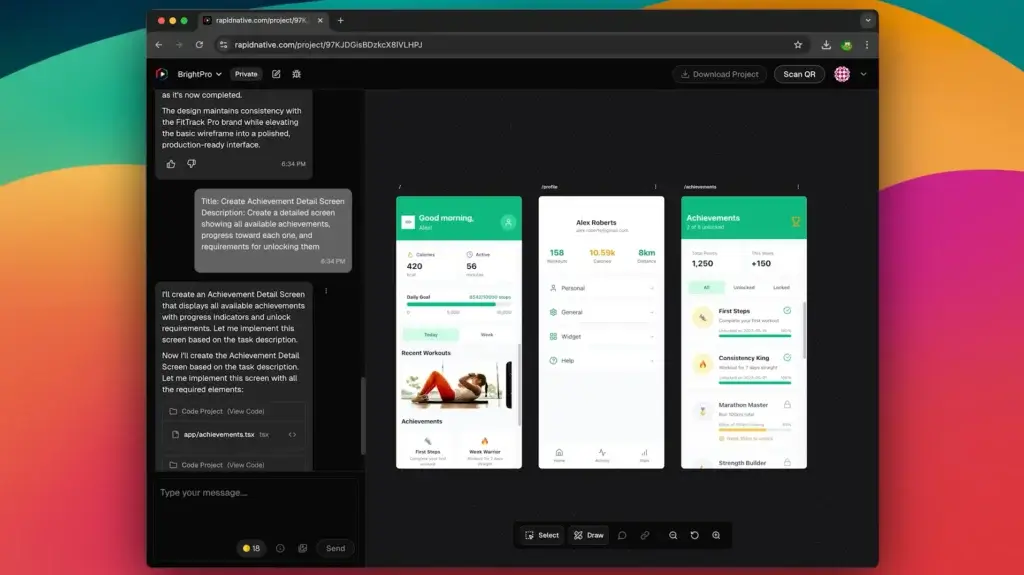Introduction
AI-driven development platforms are reshaping how teams design, build, and deploy software. RapidNative positions itself as a powerful solution for accelerating development workflows by turning natural language prompts into production-ready components and applications. Whether you want to speed up prototyping, reduce engineering overhead, or empower non-technical contributors, this platform aims to deliver a faster and more structured approach to modern app creation.
In this review, you will explore how RapidNative works, what it offers, and where it stands compared with other AI development tools such as Base44, Cursor, Lovable, and Emergent. The goal is to help you understand whether RapidNative fits your team’s development needs and how it performs in real scenarios.
What Is RapidNative?
Overview of this AI-powered application development platform
Platform overview and positioning
RapidNative is built around the principle of converting natural language prompts into real, functioning mobile applications built with React Native and Expo. According to early users, its key appeal lies in reducing boilerplate, scaffolding entire screens, navigation flows, and UI component structures with minimal manual effort.
This means you don’t just get isolated code snippets, you’re getting scaffolding you can iterate on and extend.
Who should use it (and who should think twice)
You should consider RapidNative if you meet one or more of the following:
- You’re validating a mobile app idea and want a working prototype fast.
- You’re a developer who wants to accelerate initial screen builds and layout components.
- Your team includes a designer or product manager who wants to translate designs into code without hand-coding everything.
However, you might think twice if: - You need deep customization, highly complex logic or tight control over every line of code from day one.
- Your build needs to integrate very complex custom back-end logic or third-party SDKs that the generator may not support out of the box.
- You operate in an enterprise environment with heavy legacy code or strict architecture constraints.

Key Features
RapidNative Features and Capabilities
AI Prompt-to-App Workflow
RapidNative’s standout feature is the ability to generate full app screens from text prompts. You type something like “Create a user profile screen with avatar, name, stats, and settings button”, and the system outputs a structured React Native screen with navigation paths, UI components, and styling. A strong visual or screenshot here would help illustrate the workflow (suggest capturing the UI canvas + generated code export view).
You can iteratively refine the prompt, change layout, styling, add interactions, and the tool regenerates accordingly.
Code Export & Ownership
Unlike many no-code platforms, RapidNative emphasises developer-centric output: you receive code you can export, commit to your repository, and extend as needed. That means you avoid vendor lock-in and you have full ownership of the underlying stack.
The platform supports modern technologies like TypeScript, NativeWind styling, and Expo (or standard React Native CLI) export options.
Visual Canvas, Navigation Flows & Preview
The tool provides a visual canvas view of screens and flows, making it easier for non-developers (product/design) to contribute. You can preview the result live, inspect the file structure, and test navigation paths before downloading the project.
This aspect improves collaboration between design, product, and engineering teams.
Integrations, Team Workflow & Versioning
RapidNative supports team collaboration features, private/public projects, team roles, code downloads, and presumably version control integration (e.g., GitHub). These features are critical if you’re using it in a small team rather than as a solo prototyping tool.
Look out for how the platform handles code merges, branching, and team review workflows, as these are often pain points in AI-generated code environments.
Security, Performance & Code Quality
Given that the output is intended for production or near-production use, quality matters. RapidNative claims the generated code is clean, modular, and maintainable.
You’ll want to evaluate:
- How readable and idiomatic the code is.
- Whether dependencies and architecture follow best practices.
- How well performance and code size are handled (e.g., navigation, lazy loading, modularisation).
- Security features and how the platform handles sensitive data, API integration, and native modules.

Pros and Cons
Advantages and Limitations
Evaluating the strengths and limitations of RapidNative will help you understand how it fits into your development workflow and whether the platform aligns with your technical requirements. This section goes beyond surface-level observations to give you a more realistic picture of how RapidNative performs in real use cases.
Positive
✅ Impressive speed
✅ Creates clean TypeScript code
✅ Supports Expo and modern styling frameworks
✅ Enables rapid prototyping
Negative
❌ Complex business logic often requires manual adjustments
❌ Generated designs may require refinement
❌ Inconsistent spacing or styling
❌ Lack of team features like versioning
✅ Pros
RapidNative delivers meaningful advantages if you want to accelerate mobile app development without sacrificing code ownership.
- Generates production-ready React Native components at impressive speed.
- Creates clean TypeScript code that follows predictable patterns.
- Supports Expo and modern styling frameworks, which improves portability.
- Enables rapid prototyping for stakeholders who want to see screens quickly.
- Visual interface makes it easier for non-technical contributors to participate.
- Reduces repetitive coding work, especially for layouts and UI structures.
Each of these benefits contributes to a more streamlined development process. If your team frequently builds similar UX patterns or needs to test product ideas quickly, RapidNative helps you reduce the time spent on boilerplate and early-phase development.
❌ Cons
As with any AI-driven development tool, RapidNative also presents some challenges you should consider before fully integrating it into your workflow.
- Complex business logic or custom native modules often require manual adjustments.
- Generated designs may require refinement to match your brand or UI standards.
- Some prompts produce inconsistent spacing or styling that needs cleanup.
- Integration-heavy apps may not generate perfectly without human engineering input.
- Team features like versioning and collaborative editing are still maturing.
These limitations do not prevent you from using RapidNative effectively, but they mean the platform is best used as a powerful accelerator rather than a complete end-to-end development replacement.
Speed and Quality
Performance and Accuracy
Performance, speed, and output quality are essential considerations when you evaluate an AI-powered development platform. You need to know whether the generated code performs reliably and whether it meets modern development standards. RapidNative performs strongly across these areas, especially when used for prototyping or UI-heavy workflows. ⚡
Speed of Code Generation
RapidNative produces full screens in a matter of seconds, enabling a level of iteration that would normally require significant engineering time. This speed becomes especially valuable when you are:
- Validating product ideas,
- Preparing demos for stakeholders,
- Running quick design-to-code conversions,
- Or iterating on UI refinements in real time.
This responsiveness enhances creativity because you can experiment more freely with design variations without waiting for long build cycles.
Accuracy and Structure of Generated Code
The accuracy of the output largely depends on the clarity of your prompts, but the platform consistently delivers code that is logically structured and easy to review. The output typically includes:
- Clear component separation,
- Predictable folder structure,
- TypeScript typing for better maintainability,
- Modern utility-based styling options,
- Navigation structures that align with established React Native patterns.
If you already work with React Native or Expo, the generated code feels familiar and remains easy to integrate into existing repositories.
Performance and Stability of Generated Apps
Because RapidNative outputs real React Native code, performance matches what you would expect from any manually written application. This represents a major advantage over traditional no-code builders, where runtime performance often suffers due to abstraction layers.
You still need manual engineering oversight for advanced optimizations, especially if your application depends on heavy animations, gesture-based interactions, or complex API layers. However, the baseline performance is stable and reliable.
User Experience
Ease of Use
User experience plays a major role in how quickly you can adopt a new development platform. RapidNative does a strong job of making its workflow accessible, even if you are new to AI-driven development. The interface remains clean, responsive, and intuitive, which helps both developers and non-technical teammates move through the workflow confidently.
Interface and Navigation
RapidNative’s interface is designed around clarity and efficiency. The main dashboard gives you direct access to your projects, generated screens, code exports, and navigation settings.
You can switch between prompt-based generation, visual editing, and code preview with minimal friction, allowing you to stay focused on your build rather than hunting for features.
The layout feels familiar if you have used design tools like Figma or prototyping tools like Bravo, which reduces onboarding time.
Learning Curve
RapidNative strikes a good balance between accessibility and depth.
Non-technical contributors can use natural language prompts to generate screens or adjust layouts. Developers get full code visibility, so there is no sense of a closed system.
If you already understand React Native fundamentals, you will adapt quickly because the generated code mirrors real-world project conventions.
Beginners can use the platform to learn component structures and styling patterns, although they will still rely on prompts rather than deep code edits initially.
Collaboration and Team Workflow
RapidNative includes features for shared workspaces, allowing multiple team members to access the same project. This is particularly valuable if you have designers or product managers who want to contribute without writing code.
While collaboration tools are evolving, they already support:
- Shared projects,
- Team roles and permissions,
- Export management,
- Consistent UI previewing.
These features make RapidNative more viable for cross-functional product teams.
Previewing and Iteration
The instant preview is one of the strongest elements of the user experience. You can make changes, adjust prompts, and verify screen behavior immediately. This eliminates long feedback loops and reduces friction between design intent and implementation.
Developers can focus more on logic and integrations, while stakeholders can visualize and test UI flows early in the process.

Pricing and Plans
RapidNative Pricing in 2025
RapidNative offers a simple and predictable pricing structure designed to support individual developers, small teams, and growing startups. The platform focuses on providing access to its AI generation capabilities, visual workflow, and export options without creating heavy usage constraints. This makes it suitable whether you are experimenting with an idea or working on a full product build.
Pricing Overview
RapidNative provides two main subscription levels:
- A Free Tier that lets you explore the platform and generate basic screens.
- A Pro Tier that unlocks higher limits, advanced features, and full code export capabilities.
| Plan Features | Free Plan | Pro Plan |
| AI Generation Credits | Limited credits | Higher credit allocation |
| Export Options | Basic preview only | Full React Native, Expo, TypeScript export |
| Team Collaboration | Not included | Includes team projects and shared workspaces |
| Project Privacy | Public or limited private | Full private projects |
| Support Level | Community | Priority support |
Who Each Plan Is Best For
- Free Plan: Perfect if you want to explore the platform, test the UI generation workflow, or validate an early concept.
- Pro Plan: Best for developers, designers, and product teams who want full export control and consistent AI generation without strict limitations.
Alternatives
RapidNative vs Competitors
If you are evaluating RapidNative, you should also compare it with other AI-powered development platforms. Each tool emphasizes a different approach, so understanding these differences helps you choose the right environment for your workflow.
Cursor
Cursor is an AI IDE built for developers who prefer writing code in a traditional environment while leveraging AI assistance.
How it differs from RapidNative:
- Cursor is more code-first and integrates deeply with your local environment.
- It excels at refactoring, debugging, and extending existing codebases.
- RapidNative is stronger for visual prototyping, screen generation, and early UI stages.
Choose Cursor if you want AI integrated directly into your coding workflow. Choose RapidNative if you want fast, visual app generation.
Base44
Base44 focuses on full workflow automation for long-form content creation and structured app behaviors.
Differences:
- Base44 is more automation-oriented and less focused on visual UI generation.
- RapidNative offers stronger mobile UI scaffolding and screen previews.
Base44 works well for teams building internal tooling and productivity flows. RapidNative is better for mobile-native product development.
Lovable
Lovable uses AI to generate complete web applications with a strong emphasis on modern UI frameworks and fast iteration.
Differences:
- Lovable is web-first and optimized for React web apps.
- RapidNative is mobile-first and optimized for React Native and Expo builds.
Choose Lovable if your focus is on responsive web experiences. Choose RapidNative if your priority is iOS and Android applications.
Emergent
Emergent blends AI coding with advanced agentic behavior that can manage tasks, build modules, and refactor autonomously.
Differences:
- Emergent is built for long development cycles with complex automation.
- RapidNative is better when you need rapid visual development and clean mobile UI generation.
Emergent works well for engineering-heavy workflows. RapidNative fits teams that want speed and clarity when building native applications.
Getting Started Guide
How to Get Started With RapidNative
This step-by-step guide helps you begin using RapidNative effectively, whether you are creating your first prototype or integrating it into a collaborative product workflow.
1. Create Your Account
Sign up through the RapidNative website. The onboarding process is simple and gets you into the editor within a minute.
2. Start a New Project
Create a project name and select a template if available. This gives you a centralized space for screens, prompts, and exports.
3. Write Your First Prompt
Use natural language to describe the screen you want.
Example:
“Create a login screen with email input, password input and a blue primary button.”
The system will generate a React Native screen with these elements.
4. Refine the Design
Adjust your prompt or add details until the screen meets your expectations.
You can control layout, spacing, components, or stylistic direction.
5. Explore Navigation and Multi-Screen Flows
Add screens and define navigation paths. The platform updates your flow automatically.
6. Preview the App
Use the built-in preview to test positioning, behavior, and layout.
This helps you catch early design inconsistencies without building locally.
7. Export the Code
When you are satisfied, export the project as React Native or Expo code.
Import it into your IDE to start adding logic, API integration, or custom styling.
8. Collaborate With Your Team
Invite designers, product managers, or engineers to comment, generate screens, or refine flows.
This reduces the friction between design and engineering handoff.

Conclusion
Final Thoughts
RapidNative stands out as an efficient and approachable AI-powered development tool for mobile applications built with React Native and Expo. You get fast code generation, visual previews, modern TypeScript output, and clean screen structures that accelerate early development phases significantly.
If your focus is on validating mobile ideas, generating prototypes, or speeding up UI development, RapidNative provides strong value. It does not eliminate the need for developers, especially for complex logic or advanced integrations, but it reduces repetitive tasks and helps your team build momentum early in a project.
For teams balancing speed, collaboration, and code quality, RapidNative is a compelling addition to your development workflow.
Have more questions?
Frequently Asked Questions
1. What can I build with RapidNative?
You can build a wide range of mobile screens and flows, including dashboards, forms, onboarding, authentication, and more, all using React Native.
2. Does RapidNative work for non-developers?
Yes, the prompt-based and visual interface makes it possible for product managers and designers to contribute, although developers are still needed for advanced logic.
3. Can I export the code to my own project?
Yes, you can export TypeScript, Expo, or React Native code and use it in your repository.
4. Is the generated code production-ready?
The code is clean and structured, but you should review it before production, especially for complex or performance-sensitive features.
5. Does RapidNative support API integrations?
You can integrate APIs after exporting the code. The platform generates UI and layout, and you extend it with logic.
6. Is there a free version of RapidNative?
Yes, RapidNative offers a free tier suitable for exploration, initial prototyping, and basic screen generation.
7. Can I use RapidNative for full apps or just components?
You can generate full screens, navigation flows, and app structures, not only individual components.
8. Does RapidNative support Expo?
Yes, Expo exporting is one of its strongest capabilities and provides a faster mobile development experience.
9. How does RapidNative compare to traditional no-code tools?
RapidNative gives you real code that you own, which eliminates vendor lock-in and gives you full control of the final product.
10. Is RapidNative suitable for teams?
Yes, it includes team project sharing and basic collaboration features, making it useful for cross-functional teams working on mobile-first products.







